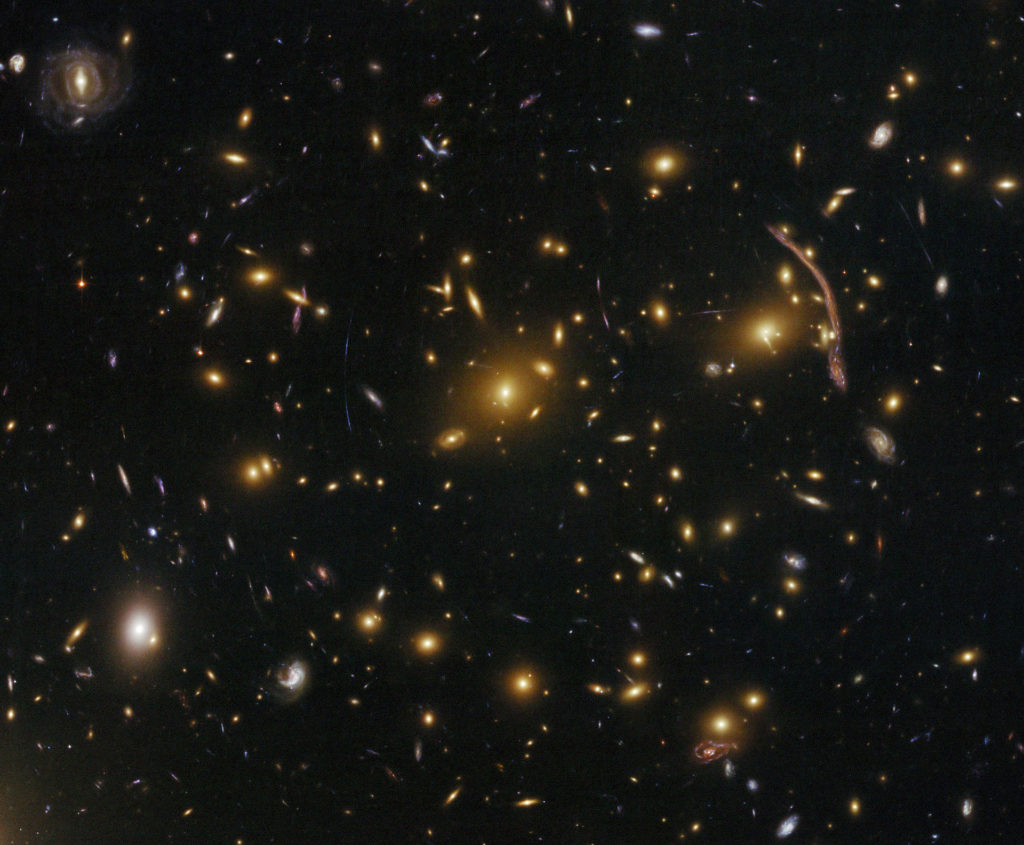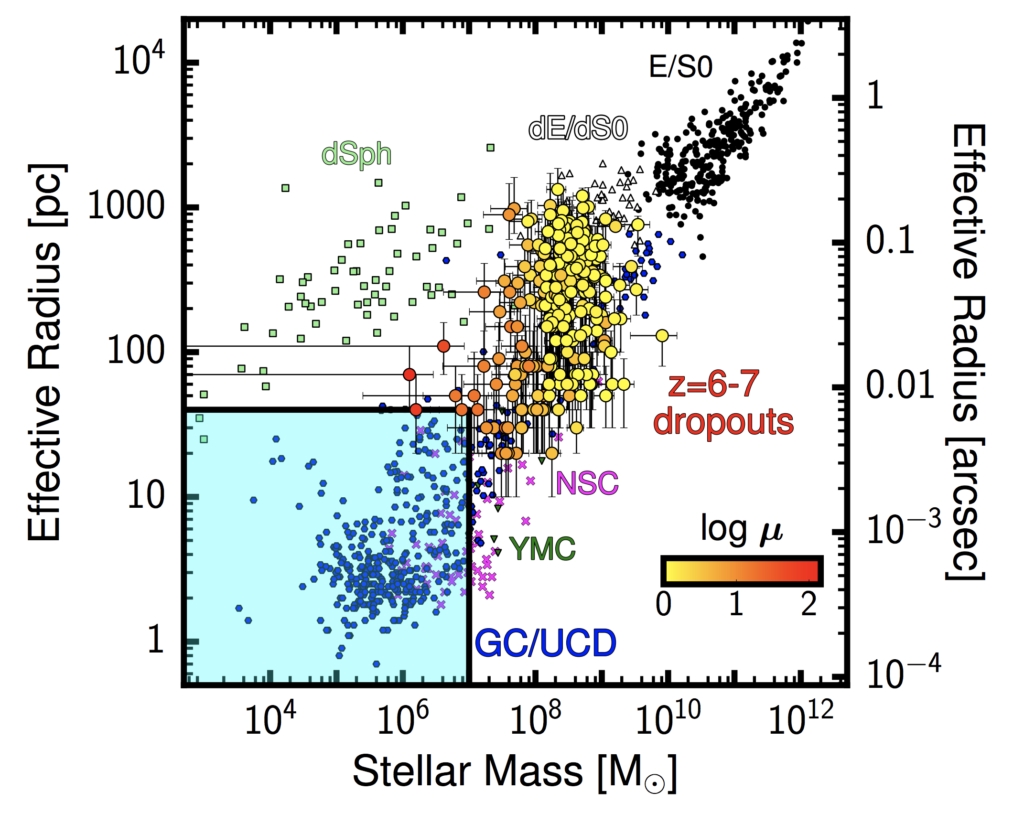Authors: Shotaro Kikuchihara, Masami Ouchi, Yoshiaki Ono, Ken Mawatari et al.
First Author’s Institution: Institute for Cosmic Ray Research, The University of Tokyo
Status: Submitted to ApJ
In the coming years, we will see the launch of one of the most powerful space-based telescopes ever built, the James Webb Space Telescope (JWST), and we will see a new class of colossal ground-based observatories built with primary mirrors exceeding 30 meters in diameter. However, despite all of our technical ingenuity, the most powerful telescopes in the universe are in fact galaxy clusters. As the most massive gravitationally bound structures, galaxy clusters severely distort their local spacetimes and can magnify substantial areas of the sky through the phenomenon of gravitational lensing. Cluster lenses allow astronomers to observe many distant sources in unprecedented detail that would otherwise be too faint to study (e.g., Fig. 1). Indeed, the possibility of discovering and characterizing some of the earliest and most distant galaxies observable was a primary motivation for conducting a deep survey of six galaxy clusters known to be powerful lenses. This project, dubbed The Hubble Frontier Fields, involved hundreds of hours of observations with the Hubble Space Telescope and the Spitzer Space Telescope. By combining our best telescopes with those that nature provides, astronomers uncovered hundreds of distant galaxies from times as early as one billion years after the Big Bang. In this astrobite, we cover a work that uses this rich sample of galaxies to trace the growth of stellar mass across the first few billion years of the universe.

Hundreds of Magnified Galaxies
In this paper, the authors exploit the power of gravitational lensing to magnify and reveal intrinsically faint sources at great distances, sources that would otherwise be impossible to study. The team begins by identifying high-redshift galaxies through the Lyman break method, (a.k.a., the “dropout” technique). UV radiation from distant galaxies is absorbed by neutral intervening gas, causing high redshift sources to appear faint in blue filters – thus, high redshift galaxies can be identified quickly by their colors. Combining all available imaging of the Hubble Frontier Fields, the team uses the Lyman break method to find a total of 357 magnified galaxies at 6 < z < 9, when the universe was less than a billion years old.
In order to study the full sample of galaxies in detail, the authors required carefully manicured images of their targets; at these distances, all galaxies appear extraordinarily faint, and low-mass galaxies typically go undetected. To alleviate this, the authors first correct for the magnification introduced by the cluster lenses using magnification maps provided by the Hubble Frontier Fields science team. Afterwards, the team creates image stacks of sources binned according to their apparent magnitudes, rewarding the team with high signal-to-noise (S/N) images which provide accurate photometry of the even the faintest galaxies at their sample.
Galaxy Evolution Metrics
Nearly all physical parameters of galaxies affect the way they emit light. This means that it is possible to recover the properties of galaxies by modeling their SEDs, or spectral energy distributions. To characterize each source, the team builds SED models that account for redshift, age, ionization state, stellar mass, stellar metallicity, dust content, and contribution from nebular emission. The constraints provided by high S/N photometric measurements across ten filters exceeds the number of free parameters, ensuring well-constrained models.

The authors use the inferred properties from their models to trace fundamental aspects of galaxy evolution, in particular the growth of stellar mass in galaxies during the first few billion years of the universe. A key observable in this regard is the galaxy stellar-mass function (GSMF; Fig. 2 left), which describes the average number-density of galaxies in the universe as a function of stellar mass. Integrating the GSMF gives the galaxy stellar mass density (GSMD; Fig. 2 right), which is the average density of stellar mass throughout the universe. Measuring these quantities across redshifts quantifies the growth of galaxies’ mass in stars throughout cosmic time, providing a simple benchmark for all theories of galaxy evolution.
While the GSMF has been well studied at low redshift, much is unknown about the GSMF in the early universe, especially at low masses. Fortunately, the high magnification due to lensing reveals some galaxies studied here with masses as low as Mstellar ~ 106 M☉, an extraordinary measurement at these distances. Consequently, this work provides some of the first constraints on the physical characteristics of such low mass galaxies during this epoch. At higher masses, the GSMF they measure is mostly consistent with previous works. However, at the highest redshifts, the authors find a greater abundance of massive galaxies than previous works. Furthermore, the authors measure higher stellar mass to (intrinsic) UV luminosity ratios. These pieces of information reveal that these massive star-forming galaxies favor a duration of star formation lasting ~ 100Myr, rather than a shorter, dramatic buildup of stars on shorter timescales suggested by other astronomers. In other words, the evolution of star formation rates is mostly smooth during these time periods. Regardless, further work is needed to ultimately constrain these evolutionary trends, given the current uncertainties on the massive galaxies in their sample.
Globular Cluster-type Sources Beyond z ~ 6…?
The mass-size relation in galaxies encodes fundamental differences in galaxy types. The last piece of this work involves assessing the masses and physical sizes of these distant galaxies and comparing these characteristics to those of more local sources. The authors combine the physical sizes obtained in a previous work with their inferred stellar masses and make an exciting discovery. Two sources, magnified by factors of ~ 20 and 80, have stellar masses (Mstellar < 107 M☉) and physical sizes (R < 40kpc) that make them comparable to globular clusters observed in the Milky Way (Fig. 3). The authors conclude that these sources could be members of a dominant class of low-mass galaxies expected to exist at these redshifts and could even be related to modern day globular clusters, which are known to have populations of old stars. These sources are particularly interesting, as it is thought that low-mass galaxies such as these likely evolve into Milky Way-sized galaxies we see today. Future telescopes, like the James Webb Space Telescope, may be able to obtain spectroscopic observations of these compact sources and reveal even more insight into their physical qualities.

Gravitational lensing by galaxy clusters provides a unique window to the high-redshift universe. Thanks to these cosmic lenses, the authors were able to study the growth of stellar mass in galaxies during early times in the universe and probe some of the lowest mass systems ever detected beyond z = 6. This work highlights some of the great science that is possible when we combine the power of the best telescopes humans have made with these otherworldly lenses. Indeed, this combination ensures a truly remarkable view of the cosmos.




Awesome read! Thanks